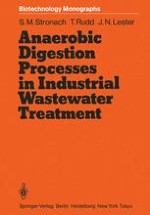There have been many significant microbiological, biochemical and technological advances made in the understanding and implementation of anaerobic digestion processes with respect to industrial and domestic wastewater treatment. Elucida tion of the mechanisms of anaerobic degradation has permitted a greater control over the biological parameters of waste conversion and the technical advances achieved have reduced the time and land area requirements and increased the cost-effectiveness and efficiency of the various processes presently in use. By product recovery in the form of utilisable methane gas has become increasingly feasible, while the development of new and superior anaerobic reactor designs with increased tolerance to toxic and shock loadings of concentrated effiuents has established a potential for treating many extremely recalcitrant industrial wastestreams. The major anaerobic bioreactor systems and their applications and limitations are examined here, together with microbiological and biochemical aspects of anaerobic wastewater treatment processes. London, June 1986 S. M. Stronach T. Rudd J. N. Lester v Table of Contents 1 The Biochemistry of Anaerobic Digestion 1 1. 1 Kinetics of Substrate Utilisation and Bacterial Growth 3 1. 1. 1 COD Fluxes and Mean Carbon Oxidation State 3 1. 1. 2 Bacterial Growth and Biokinetics 4 1. 1. 2. 1 Growth and Single Substrate Kinetics 4 1. 1. 2. 2 Multisubstrate Systems . 8 1. 2 Kinetics and Biochemistry of Hydrolysis 8 1. 3 Kinetics and Biochemistry of Fermentation and J1-0xidation . 11 1.
